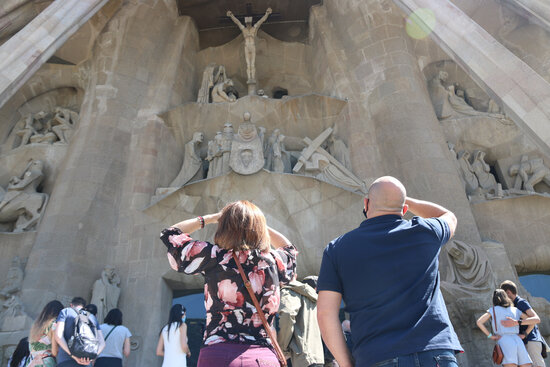Sagrada Família stairways plan threatens eviction for up to 3,000 people
A 60-meter long stair designed up to the entrance causes disputes between neighbors and basilica

Once construction finishes, Sagrada Família will become the highest church in the world, and the tallest building in Barcelona, reaching 172.5 meters. The temple will transform the city’s skyline even more so than it already does, but for the moment, one major hurdle remains at ground level.
A dispute between neighbors and the basilica arises from the project to build stairways. The steps would go from Glory façade, the Sagrada Família’s main face, to Aragó street, around 60 meters in length. To do so, they will need to demolish several buildings which would see around 3,000 people evicted.
One of these neighbors is Salvador Barroso. He is the president of a group called People Affected by the Construction of the Sagrada Família. He blames the temple for planning to build this stairway and demolish his home.
He tells Catalan News that temple constructors "are evicting me after I’ve paid for my home. Why? Because of the stubbornness of the Sagrada Família to build a staircase that wasn’t in Gaudí’s plans."
The architect most widely attributed with the Sagrada Família, Antoni Gaudí, died in 1926. A decade later, many of the original plans and models to build the art nouveau masterpiece were destroyed in the Spanish Civil War, ensuring controversy survives to the present day over how Gaudí’s original designs looked.
Barroso quotes experts to say that "these stairs are not Gaudí’s and they were designed later by his disciples to have an excuse to ask for donations."
Sarcastically, he adds that the temple resembles "sci-fi movies, such as Star Wars," because of the different designs between the Nativity façade, the one that Antoni Gaudí oversaw, and the Passion façade, finished in 2008 after decades of construction.
Opposed to neighbors’ beliefs, the Sagrada Família construction team does attribute the stairs to the architect, quoting an article published in the La Veu de Catalunya newspaper from October 10, 1907, when the genius was still alive.
"The temple entrance remains unsolved, and the main door because of the height starts at a first-floor level and to access it, Gaudí has designed a bridge over the street finishing with two big stairways," the article reads.
A problem decades in the making
It was 1975,when Núñez y Navarro, one of the biggest construction companies in Barcelona, started work on the apartment buildings in Carrer de Mallorca, the street of the main façade of the Sagrada Família, that are affected by the plans.
At the time, the Spanish Science and Education ministry said there were “no plans from Gaudí for the stairs," and the Catalan Architects Association said that it is not possible to attribute the stairs or even any single overall project of the basilica to Antoni Gaudí.
Based on these documents, Barroso’s platform has sued the temple foundation and a special Metropolitan Regulation Plan approved by the city council regarding the Sagrada Família.
The case in Catalonia’s High Court is currently held up with delays due to Covid-19, but sources confirm to Catalan News that a verdict is expected by the end of 2022.
City Council conflict intermediary
These stairs have been a long-term argument between residents and the temple. Before Covid-19, the local council organized a meeting between the two parties, but they only met once, right as the pandemic was about to begin.
In November, however, Barcelona’s deputy mayor in charge of urban planning, Janet Sanz, announced a new meeting before the end of the year.
At an urbanism committee meeting, Sanz said that her "personal goal, shared with [her] team, is to organize meetings with each side of the dispute and then organize, before the end of the year, a new meeting and we’ll have these gatherings to tackle this issue that is very complex."
But the neighbors affected by the project say they have not heard about any of these meetings mentioned by local authorities, despite officials having the contact details of the association.